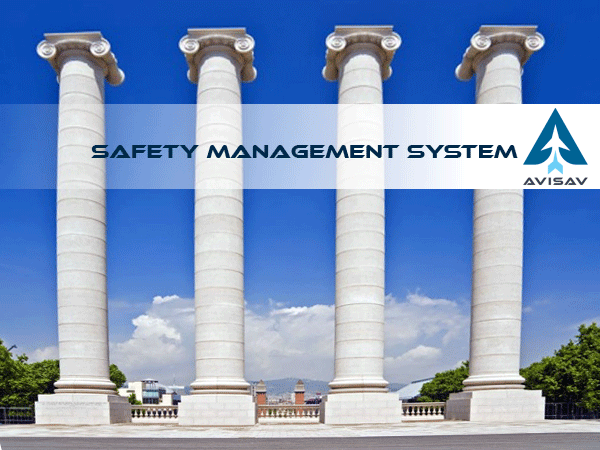
Efficient implementation of the safety management system (SMS) is the key to the detection of safety hazards and safety risks. It is the main tool for keeping these hazards at an acceptable level for the safety (ALoS) of all stakeholders and participants in different aviation processes. It is also one aspect of implementing the integrated Quality & Safety Management System (QSMS)
As a matter of fact, SMS provides resources to detect security hazards for implementation of the activities required to reduce safety risks. Additionnaly, to monitor safety and security performance, and to constantly improve the safety performance.
Equally, this also includes requirements for deployment of the safety management system (SMS) by the service provider and the airline operator as an element of each state SSP.
Being that, the SMS framework requires special activities and processes. Aviation services providers should carry out these activities and processes in a systematic fashion (this is the mere definition of SMS). Of course, these are thoroughly described in the postulates of the SMS.
The framework of the four pillars of the SMS
In the first place, there are four components. Identically, known as pillars of SMS, including twelve elements that compose it, included in, and more in ICAO Doc. 9859 – Safety Management Manual.
Namely, the International Civil Aviation Organization has provided a detailed description of all four pillars that carry the Safety Management System with thorough procedure instructions in 2006. This is the year when the ICAO also decided that the commercial aviation service providers must implement the safety management system.
Nowadays, all four pillars are a must and they form the complete image and an advanced safety system. The framework of the SMS pillars is not equal for each particular pillar. Namely, some pillars carry more weight than others. Some of them are the prerequisite for the others. Ultimately, they are all interconnected. Now, let’s take a look at those four pillars.
Four SMS pillars / components
So, in short, four pillars of SMS and the twelve elements that compose it include:
1.1 Commitment and Responsibility of the Management
1.2 The ultimate responsibility for the safety
1.3 Identification of the key safety staff
1.4 Coordinating the planning of procedures in the case of emergency; Emergency Response Plan (ERP)
1.5 SMS documentation
2.1 Risk/hazard detection and identification
2.2 Assessment and mitigation of risks
3.1 Monitoring and Measurement of Safety Performance
3.2 Managing Changes
3.3 Continuous improvement of SMS
4.1 Training and education
4.2 Safety communication.
Provided that, each of these four pillars is essential for the proper functioning and integration of the Safety Management System, there are two key operational activities that lead to a successful SMS in aviation.
With this in mind, SMS aims to result in designing and implementing organizational processes and procedures that lead to the identification of safety hazards. Therefore, the two most important, essential SMS pillars or operations are pillars number 2 and 3. Those are the SRM, which stands for safety risk management, and safety assurance.
Hence, risk management and safety guarantees should be two of the basic activities when designing and planning the SMS focusing on initial analysis and identification of risks/hazards.
Who is responsible for the implementation of the four pillars of SMS?
First, in each organization, including aviation, management is in charge of coordinating staff activities. Similarly, management is responsible for the way of the use of the funds that are directly related or necessary for the provision of the services. Consequently, this implies safety services and procedures as well. Hence, let’s see how management carries its responsibility for the implementation and improvement of the four SMS pillars.
Through specific staff activities and resource allocation, management plays an active role in the control of safety risks and hazard levels associated with risks/hazards. Accordingly, management is in charge of selection, training, education, and supervision of staff to ensure a high level of quality and safety of the aviation services.
Also, management provides, conducts, and supervises staff testing when it comes to safety issues. Additionally, they are also responsible for testing the whole system for preventive approach reasons.
As a matter of fact, all aviation-related companies must understand that the starting point for ensuring the effectiveness and efficiency of the Safety Management System is defining, implementing, and updating the safety policy of the organization. Senior management must develop the organization’s safety policy, in accordance with the SMS, approved by the responsible administrator (local civil aviation authority).
Safety Policy
Generally speaking, the safety policy must:
- Above all, ensure the attainment of the highest safety standards;
- Ensure compliance with all relevant international legal regulations on aviation safety standards and best practice;
- Provide all necessary funds;
- Implement safety standards and procedures as the primary responsibility of all managers; and
- Ensure that the safety policy is properly understood, implemented, and maintained at all levels of the organization.
Who must implement and comply with the four pillars of SMS?
Different organizations levels and individuals should involve in the process of implementation of the four SMS pillars in the aviation sector. Also, they must base their work on the mentioned pillars. Those include:
- Aircraft manufacturers;
- Aircraft operators;
- MROs (Maintenance, Repair & Overhaul organizations);
- Training organizations and schools;
- Air navigation services providers;
- Certified, registered airports and airport operators.
- Civil aviation authorities
The Bottom Line

In conclusion, the Safety Management System is a complex system focusing on safety, human, and organizational aspects of the organizations. Its key objective focal point is ensuring that the initial identification of risks, hazards and assumptions in relation to the detection of the safety risks. Additionally, make sure that the protection implications that exist in the system as the ways of control are applicable as the system changes and develops over time. It also aims at making changes within the defense measures in case of need.
Ultimately, all principles of this complex system must be well-understood, implemented, and timely upgraded. There are four pillars of the SMS and 12 elements that form the system. Those are Safety policy and goals, Safety risk management, Safety assurance, and Promotion of safety.

